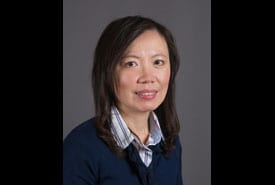At a glance
Meet Flu Fighter Dr. Tsu-Yin Wu, director of the Eastern Michigan University Center for Health Disparities Innovation and Studies (CHDIS). There, Dr. Wu and her team work to overcome disparities in health care, including cultural, language, and systematic barriers to accessing health care and preventive services.

Background
Dr. Wu and her team have worked through CDC’s Racial and Ethnic Approaches to Community Health (REACH) initiative, to address issues and scenarios where Asian-Americans have less access to health care. The team uses policy, systems, and environmental approaches to implement effective culturally tailored programs that promote health and well-being.
Name: Tsu-Yin Wu, PhD, RN, FAAN
Title: Professor of Nursing and Director of the Eastern Michigan University Center for Health Disparities Innovation and Studies (CHDIS)
Location: Michigan
What is the goal of this program?
Local Michigan data show that health disparities exist. So, the overarching goal of the different projects we are doing is to reduce health disparities and promote increased health equity for the underserved communities, particularly the communities of color. In this case, we mostly focus on Asian Americans. REACH has three focus areas or domains (nutrition, physical activity and community clinical linkage known as CCL), which is to serve clients with a chronic disease in our priority population. This flu initiative came about as part of that. CDC wants to expand the effective approaches that we been using for reaching people with chronic diseases and use those approaches to address health disparities involving flu vaccination. What we find is that we really need to know how our communities are doing to meet them where they are.
How does the program seek to address flu and health disparities?
In addition to the education campaign, we have been setting up mobile clinics. In other preventive health practices, we realized people don’t usually go to doctors when they’re totally fine. They don’t want to because of the different barriers, like language barriers. So, we are setting up mobile flu clinics to provide easy access for those in the population we’re serving. These are at convenient and timely locations. For example, we are working with J&E Community Relief in Detroit. We are setting our mobile clinic there and have some clinics at the community center where people know and go. So far, we have successfully completed 11 mobile flu clinics in the metro Detroit area and west Michigan.
Why is it important to fight flu in your program’s communities?
Due to low health literacy and in the communities where English is a second language, people are at risk of not getting the best benefits of preventive health measures, such as flu vaccination. That’s why we are doing language-appropriate culturally sensitive interventions as part of an education campaign to reach out to this underserved population. We want to empower them, so they can benefit from these preventive measures.
What would you say have been some of the successes of your program so far?
When we started this in early September, we realized that only one third of the people we surveyed got vaccinated with the flu vaccine last year. So, we know that the gap in vaccination rates has actually increased, and we use the information to understand the reason why they are not taking the shots. Then we have this huge education campaign using different languages. A lot of people do not realize Asian Americans are very heterogeneous. So, there are about 30 some countries represented, and, in our project, we are able to already translate and work with our translators in 11 Asian populations plus the Arabic-speaking population. We have those because we need to make sure the information is in a language that people have access to. We also developed educational brochures, because we found that we really needed them in a way people can obtain accurate information. So, we started understanding what the gaps were, and from there, we developed the education set to address those gaps and then translated it into languages that the people that we are serving could access.
Kudos to our team in the Center for Health Disparities Innovation. Our staff is so dedicated. When we set up the mobile clinics, it has to be on the weekend because that’s when people tell us that they can take the shots. Our staff comes out for this during non-weekday times to make vaccines and health care accessible to our communities. We also have these fabulous community partners we’ve worked with for years. They’re almost like our bridge to the respective underserved Asian communities. We are really so privileged and so honored to be able to work with these communities because of our wonderful community partners. Some of the partners and volunteers that we trained have become our community health workers. With their bilingual capacity, we are able to deliver language-appropriate messages to communities and mobilize people to come out and get flu vaccines.
